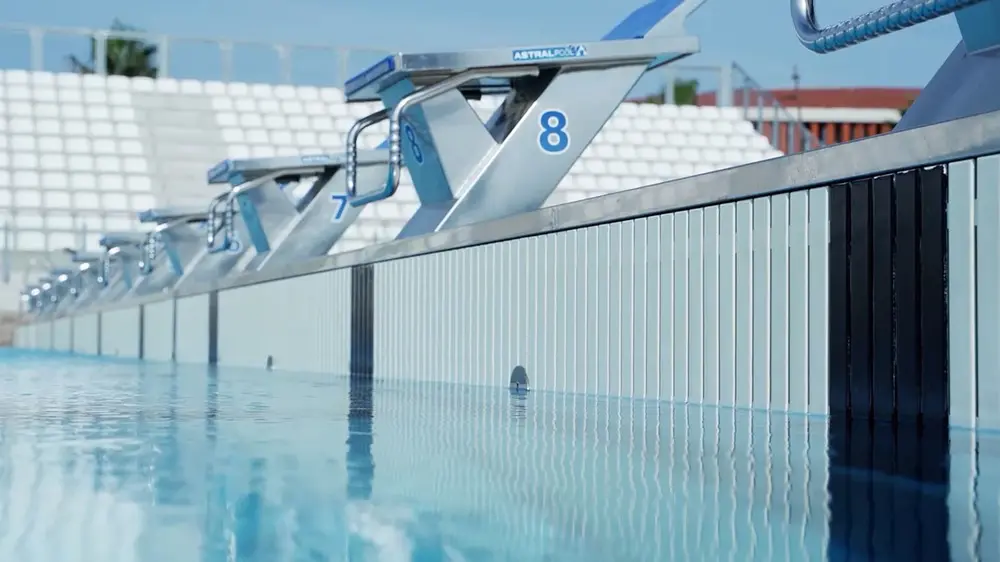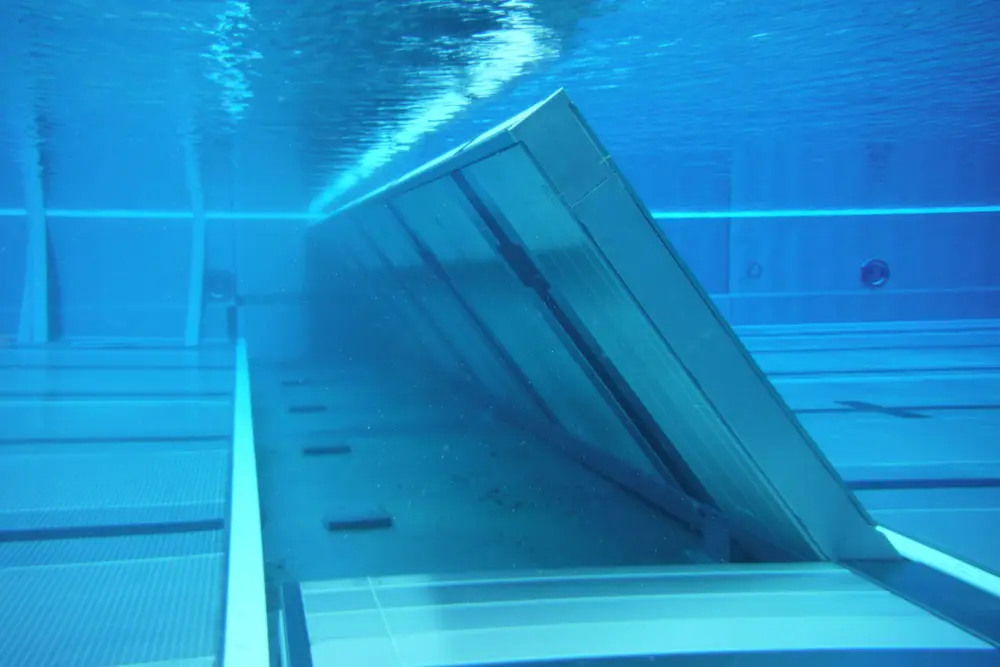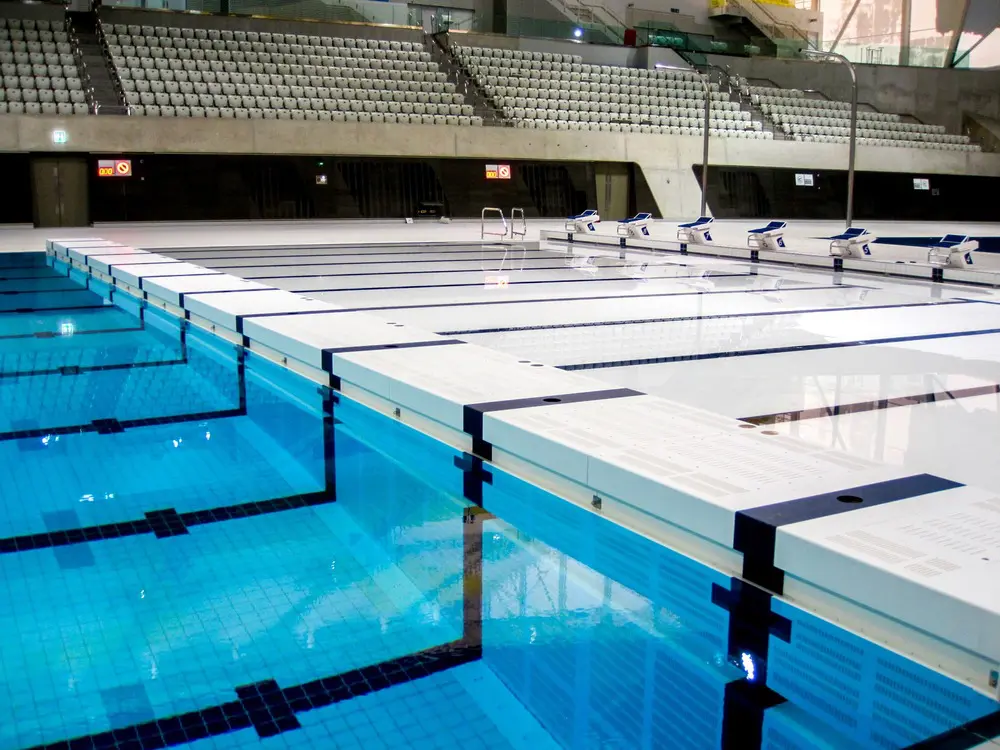A swimming pool bulkhead is no longer a niche element; it’s a strategic design consideration for maximizing aquatic facility functionality. By enabling a single pool to adapt to diverse programming needs, bulkheads enhance space utilization and operational efficiency.
Moving beyond traditional fixed pool equipment , bulkheads introduce adaptability. Their adjustability allows the pool length to be effortlessly modified based on the specific requirements of different activities or training sessions. This ensures efficient space utilization within the facility, allowing areas to cater to various user groups simultaneously.
This concise guide explores the key characteristics, operational advantages, and available types of pool bulkhead.
Dive deeper with the eBook
Key characteristics of pool bulkheads
A pool bulkhead is engineered with three key aspects in mind: functionality, durability, and swimmer safety. These features combine to create a versatile, long-lasting solution for multi-use aquatic facilities.
Core to their function is adjustability. Bulkheads reposition within the pool, effectively modifying the swimming area’s length for various activities. This allows facilities to host multiple programs concurrently, maximizing space. For instance, facility managers could transform a lap swimming area into a training ground for synchronized swimmers in a single day.
Beyond standard sizes, customization options exist to ensure seamless integration with various pool dimensions. This flexibility guarantees a perfect fit within any aquatic facility. Some bulkheads can integrate competition accessories such as starting blocks and lane lines, allowing facilities to host competitive events without additional infrastructure.
Durability is another key feature. High-strength materials like stainless steel or fiberglass ensure bulkheads withstand the constant movement and harsh environment of chlorinated pool water. This robust construction translates to long-lasting performance and minimal maintenance requirements.
A pool bulkhead is designed with swimmer safety in mind. Slip-resistant surfaces and sturdy handrails minimize the risk of falls. Some manufacturers even offer anti-entrapment gaps for further safety enhancement.

Summarized benefits of a pool bulkhead
- Versatility: By adjusting the pool’s layout, facilities can host different aquatic sports and activities simultaneously, maximizing space and usage.
- Cost-efficiency: Bulkheads eliminate the need for multiple pools, reducing operational and maintenance costs.
- Event readiness: They allow for quick configuration changes, making switching between different types of swim meets and aquatic events easier. Also, they can integrate the starting blocks for swimming and training competitions.
- Improved training: Coaches can customize pool setups to better meet the training needs of swimmers, enhancing practice effectiveness.
Types and functioning mechanisms of a pool bulkhead
When it comes to optimizing pool functionality, selecting the right bulkhead hinges on two main types, each offering distinct advantages and operation methods.
- Floating bulkheads: These lightweight, vertical structures move horizontally across the pool floor to create a physical barrier. They are ideal for facilities requiring frequent configuration changes due to their ease of movement and secure positioning. Floating bulkheads utilize a system of rails and wheels, or flotation units, for manual or automatic positioning as needed. This type of bulkhead adheres to World Aquatics regulations, making it suitable for hosting official competitions.
- Hinged and submersible bulkheads (movable walls): Permanently fixed to the pool floor with a pivot system, these bulkheads swing or fold out of the way when not in use, offering a balance between permanence and flexibility. They provide superior stability but require more effort to reposition. When not deployed, the movable wall rests completely flat within a designated recess on the pool floor, maintaining a seamless pool surface.
Both floating and hinged bulkheads offer distinct advantages. A floating pool bulkhead prioritizes ease of movement for frequent reconfiguration, while a hinged and submersible pool bulkhead provides superior stability for a more permanent pool layout. By understanding these variations, we can select the optimal bulkhead type to meet the specific needs of each aquatic facility.


A transformative element
A swimming pool bulkhead will go beyond its role as a mere space divider; it is a transformative element that will change how you manage an aquatic facility. By introducing a new level of flexibility and efficiency, bulkheads unlock the true potential of a single pool. Bulkheads adjust the pool’s length to cater to a diverse range of activities. Facilities can ditch the limitations of fixed pool configurations and embrace adaptability.
This enables facilities to expand their programming options, attracting a wider range of user groups and events. Facilities can host multiple programs concurrently, maximizing space utilization and revenue generation. Investing in a high-quality swimming pool bulkhead is not simply a matter of improved functionality; it’s a strategic decision that unlocks a facility’s full potential, transforming it into a versatile and dynamic aquatic center.
